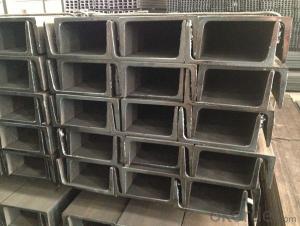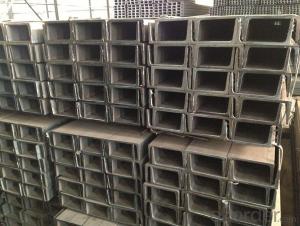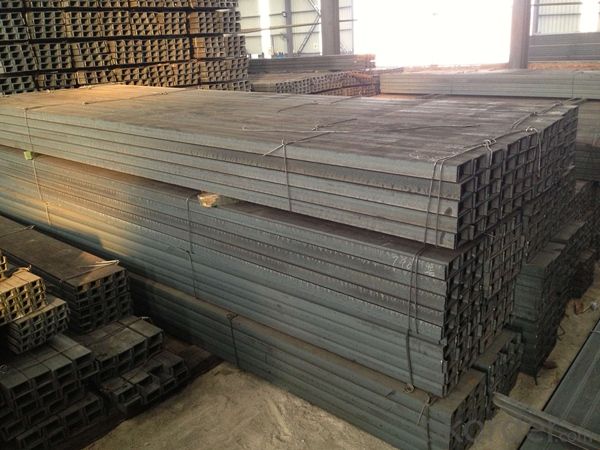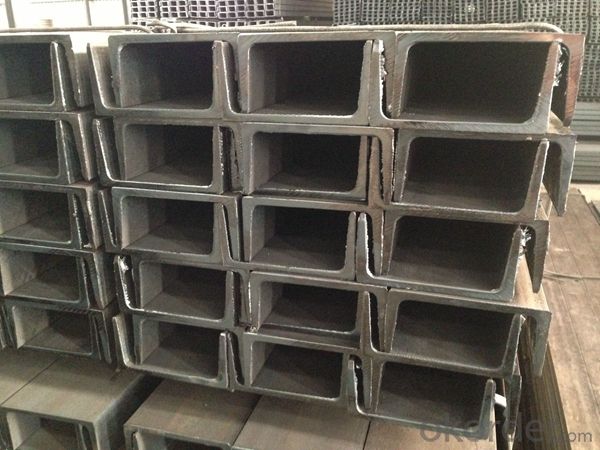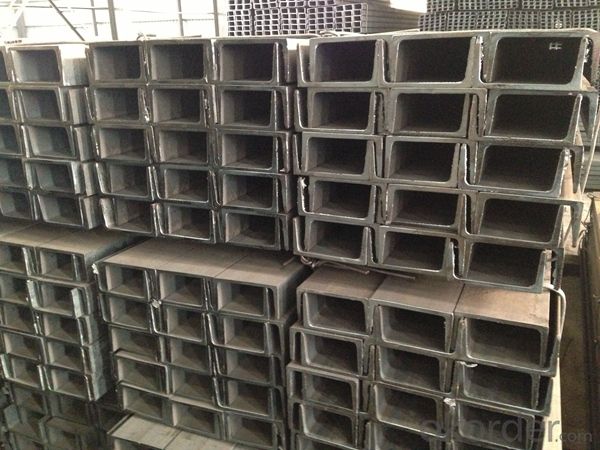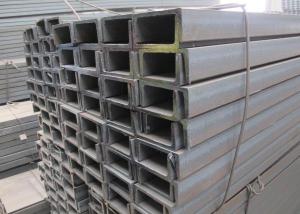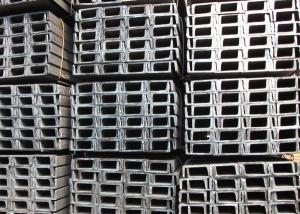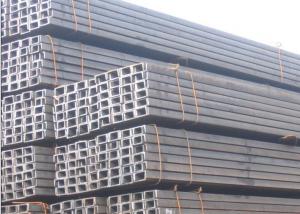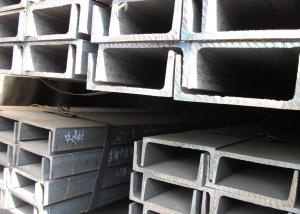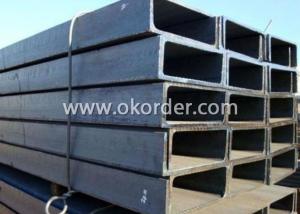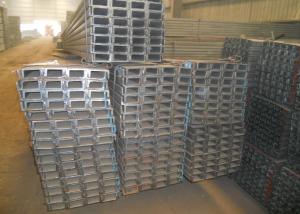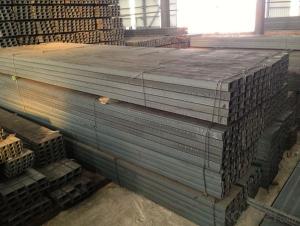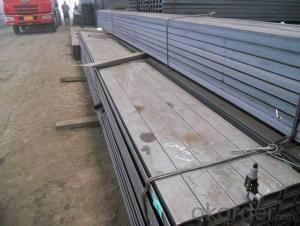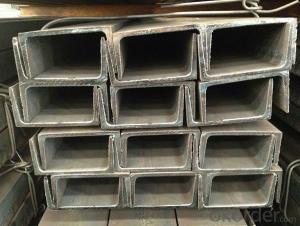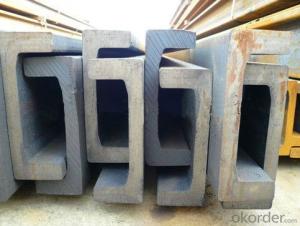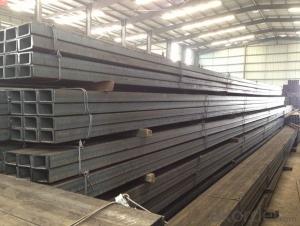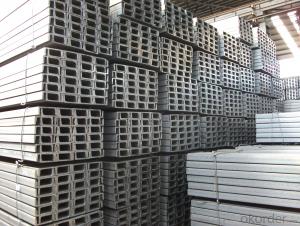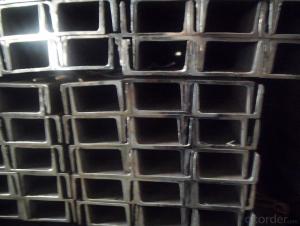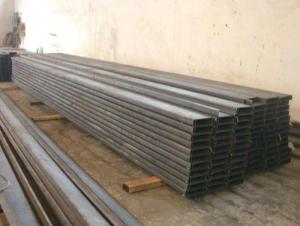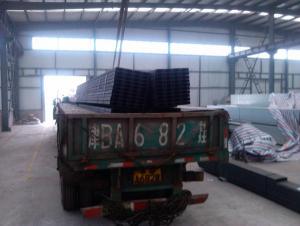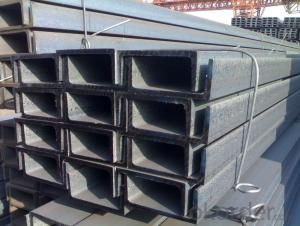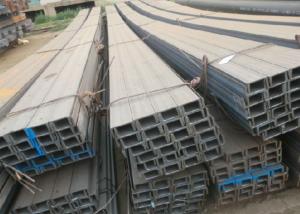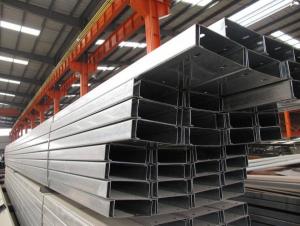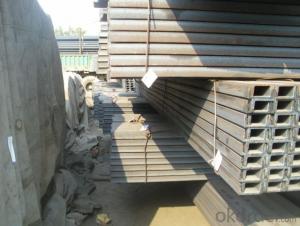Hot Rolled Mild Steel U Channel for Structure Construction
- Loading Port:
- Tianjin
- Payment Terms:
- TT or LC
- Min Order Qty:
- 25 m.t.
- Supply Capability:
- 200000 m.t./month
OKorder Service Pledge
OKorder Financial Service
You Might Also Like
Product Description:
OKorder is offering Hot Rolled Mild Steel U Channel for Structure Construction at great prices with worldwide shipping. Our supplier is a world-class manufacturer of steel, with our products utilized the world over. OKorder annually supplies products to European, North American and Asian markets. We provide quotations within 24 hours of receiving an inquiry and guarantee competitive prices.
Product Applications:
Hot Rolled Mild Steel U Channel for Structure Construction are ideal for structural applications and are widely used in the construction of buildings and bridges, and the manufacturing, petrochemical, and transportation industries.
Product Advantages:
OKorder's Hot Rolled Mild Steel U Channel for Structure Construction are durable, strong, and resist corrosion.
Main Product Features:
· Premium quality
· Prompt delivery & seaworthy packing (30 days after receiving deposit)
· Corrosion resistance
· Can be recycled and reused
· Mill test certification
· Professional Service
· Competitive pricing
Specifications of Hot Rolled Mild Steel U Channel for Structure Construction:
1. We are definitely speciallizing in manufacturing and supplying channel steel as per japanese standard, which is characterised with high mechanical strength and competitive prices.
Original Place | Tangshan, China | Brand Name | UINDA |
Standard | JIS G3192 : 1990 | ||
Material Grade | SS490 | ||
Sizes | 50mm to 200mm | ||
Sales Volume/Year | 3000MT | ||
Destination Area | Middle East, Africa, Southeast Asia | ||
2. The sections in details are as followings in the table-1
JIS U CHANNEL | Standard | Sectional | Dimension |
| Mass: |
(mm) | (mm) | (mm) | (mm) | ||
50x25 | 50 | 25 | 3.0 | 6.00 | 2.37 |
75X40 | 75 | 40 | 3.8 | 7.00 | 5.30 |
75X40 | 75 | 40 | 4.0 | 7.00 | 5.60 |
75X40 | 75 | 40 | 4.5 | 7.00 | 5.85 |
75X40 | 75 | 40 | 5.0 | 7.00 | 6.92 |
100X50 | 100 | 50 | 3.8 | 6.00 | 7.30 |
100X50 | 100 | 50 | 4.2 | 6.00 | 8.03 |
100X50 | 100 | 50 | 4.5 | 7.50 | 8.97 |
100X50 | 100 | 50 | 5.0 | 7.50 | 9.36 |
125X65 | 125 | 65 | 5.2 | 6.80 | 11.66 |
125X65 | 125 | 65 | 5.3 | 6.80 | 12.17 |
125X65 | 125 | 65 | 5.5 | 8.00 | 12.91 |
125X65 | 125 | 65 | 6.0 | 8.00 | 13.40 |
150x75 | 150 | 75 | 5.5 | 7.30 | 14.66 |
150x75 | 150 | 75 | 5.7 | 10.00 | 16.71 |
150x75 | 150 | 75 | 6.0 | 10.00 | 17.90 |
150x75 | 150 | 75 | 6.5 | 10.00 | 18.60 |
150x75 | 150 | 75 | 6.5 | 10.00 | 24.00 |
200X80 | 200 | 80 | 7.5 | 11.00 | 24.60 |
Table-1
3. The mechanical property of JIS U Channel Steel in the table-2:
Grade | Yield Strength,N/mm² | Extension Strength N/mm² | |||
Thickness of Steel,mm | |||||
≦16 | >16-≦40 | >40-≦100 | >100 | ||
SS490 | ≧285 | ≧275 | ≧255 | ≧245 | 490-610 |
Table-2
4. The chemical composition of JIS U Channel Steel as per SS490 in the table-3
Grade | Element(%) | |||
C | Mn | P | S | |
SS490 | - | - | ≦0.050 | ≦0.050 |
Table-3
Usage of Hot Rolled Mild Steel U Channel for Structure Construction:
1.The JIS U Channel Steel can be devided into two kinds, namely common channel steel and light channel steel. The sizes of hot rolled common channel steel range from 5# to 40#. Meanwhile, the channel steel can be divided into cold forming sectional equal channel steel, cold forming sectional unequal channel steel, cold forming inner edge channel steel and outer edge channel steel.
2.The JIS u channel steel is usually used for arch-itechtural structure, and they could be welded in order to support or hang a vari-ety of facilities. They are also usually used in combination with I beam. The channel steel with sizes under 14# is usually applied to construction engineering, as purline, while the channel steel with sizes above 16# is more likely to be used in building vehicle chassis structure and mechanical structure. Furthermore, the channel steel in sizes above 30# are target at building bridge structure, as tension bar.
3.In a word, the channel steel must possess perfect welding property, riveting property and mechanical property and so on.
Package & Delivery of Hot Rolled Mild Steel U Channel for Structure Construction:
1.The JIS u channel steel will be packed in bundle with steel wire at each end of every bundle and color marking in order to help the customer to recognize his goods more easily at sight.
2. And the channel steel could be loaded into 20ft or 40ft container, or by bulk cargo.If the weight of each bundle reaches more than 3.5 mt, the loading by break bulk cargo should be choosed.When the weight of each bundle reaches less than 3mt, the loading by container should be choosed.
3.As for the transportaion from mill to loading port, the truck will be usually used. And the maximum quantity for each truck is 40mt.
4.All in all, we could do in accordance with customer's request.
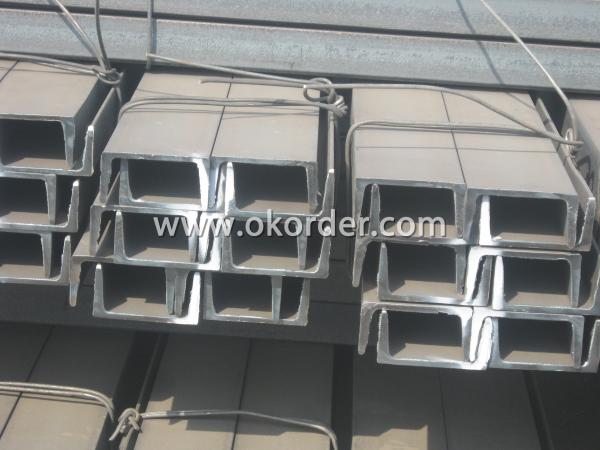
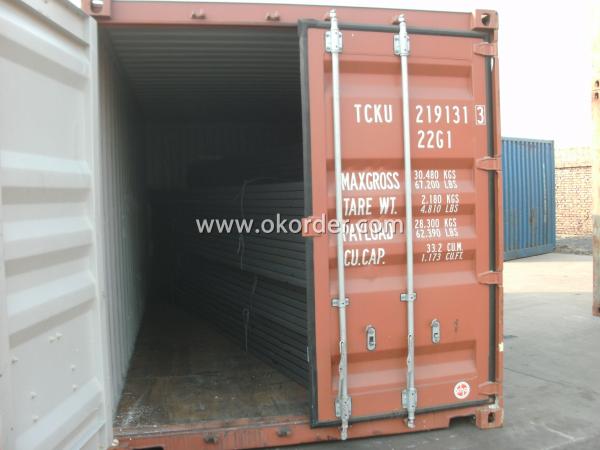
Production Flow of Hot Rolled Mild Steel U Channel for Structure Construction:
1.The steel billet shall be heated in the high temperature furnace.
2. The heated steel billet shall be rolled five to nine times with the aim of shaping the general figure of steel u channel.
3. The rolled steel u channel should be put onto the cooling bed to make the temperature low.
4. The steel u channel should be straighted on the straightener.
5. The straighted steel u channel will be cut into meters by saw, as per customer's requirements.
6. At the last part of production, the channel steel must be tested in order to confirm that the finished products are completely free from crack, pore, slag, scab or fold on the surface.
FAQ
Q1: Why buy Materials & Equipment from OKorder.com?
A1: All products offered byOKorder.com are carefully selected from China's most reliable manufacturing enterprises. Through its ISO certifications, OKorder.com adheres to the highest standards and a commitment to supply chain safety and customer satisfaction.
Q2: Can fit in the containers of 20inches the steel beams of 6M?
A2: No proble, we can put them into the containers in the form sideling.
Q3: The products are invoicing on theoritical weight or on actual weight?
A3: We can do it in both manners, according to the customers' request.
- Q: How do steel channels contribute to the overall safety of a building?
- Steel channels, also known as C-channels or structural channels, play a crucial role in enhancing the overall safety of a building. These structural components provide excellent support and stability, making them essential for constructing robust frameworks. Steel channels distribute the load evenly across a building's structure, helping to resist the forces of gravity, wind, and seismic activity. By efficiently transferring these loads, steel channels prevent excessive deflection and ensure structural integrity, reducing the risk of collapse or failure. Additionally, their high strength-to-weight ratio allows for the creation of lighter yet durable structures, enhancing the overall safety and performance of buildings.
- Q: How do steel channels contribute to the overall cost-effectiveness of a wastewater treatment plant?
- There are numerous ways in which steel channels enhance the cost-effectiveness of a wastewater treatment plant. To begin with, steel channels possess exceptional durability and a long lifespan. Consequently, they necessitate minimal maintenance and replacement, resulting in reduced operating costs. By minimizing the need for regular repairs or replacements, the overall maintenance expenses of the plant are lowered. Moreover, steel channels provide outstanding structural strength and stability. They can endure heavy loads and pressures, thereby ensuring the integrity of the wastewater treatment system. This eliminates the requirement for additional reinforcements or supports, lowering construction costs and simplifying the overall design of the plant. Additionally, steel channels offer a high degree of design and installation flexibility. They can be easily customized to meet specific project requirements, enabling efficient utilization of space and resources. This adaptability aids in optimizing the layout of the treatment plant, maximizing its operational efficiency, and reducing construction costs. Furthermore, steel channels exhibit resistance to corrosion and chemical degradation, which is imperative in a wastewater treatment environment. This resistance diminishes the need for frequent replacement or repairs due to corrosion-related issues, resulting in long-term cost savings. Lastly, steel channels are often manufactured using recycled materials, rendering them an environmentally friendly option. By employing recycled steel, the overall production costs are reduced, leading to lower material expenses for the wastewater treatment plant. This not only contributes to the cost-effectiveness of the plant but also promotes sustainability and reduces the carbon footprint associated with its construction. In conclusion, the durability, structural strength, flexibility, corrosion resistance, and use of recycled materials of steel channels all contribute to the overall cost-effectiveness of a wastewater treatment plant. These factors aid in minimizing maintenance and replacement costs, optimizing design and construction, maximizing operational efficiency, and promoting environmental sustainability.
- Q: Are steel channels suitable for use in the construction of utility poles?
- Indeed, steel channels prove to be a suitable option in the construction of utility poles. Renowned for their robustness and enduring nature, steel channels emerge as an exceptional preference for supporting utility poles. They can withstand hefty burdens and withstand unfavorable weather conditions, guaranteeing the steadfastness and durability of the utility poles. Moreover, steel channels exhibit remarkable resistance to corrosion, an indispensable attribute for utility poles frequently exposed to moisture and harsh environmental elements. Furthermore, steel channels can be effortlessly fabricated and tailored to meet distinct design prerequisites, thereby enabling flexibility in utility pole construction. On the whole, steel channels offer a dependable and effective solution for erecting utility poles, establishing them as a fitting choice within the construction sector.
- Q: Are steel channels resistant to pests and termites?
- Steel channels are highly resistant to pests and termites. Unlike wooden channels, which are susceptible to infestation and damage by termites and other pests, steel channels provide a strong barrier that pests cannot penetrate. Steel is an inorganic material that does not provide a food source or a suitable environment for pests to thrive. Whether it is rats, termites, or other pests, they are unable to chew through steel and therefore cannot cause any damage to steel channels. Additionally, steel channels are not susceptible to rot or decay, which makes them even more resistant to pest infestation. Therefore, if you are looking for a durable and pest-resistant option, steel channels are an excellent choice.
- Q: Are steel channels suitable for stadium construction?
- Indeed, stadium construction can benefit from the use of steel channels. Given their strength, durability, and versatility, steel channels find widespread application in construction ventures, including stadiums. By furnishing structural support and stability to the entire edifice, steel channels prove themselves as an ideal preference for grandiose undertakings such as stadiums. Moreover, the adaptability and fabrication ease of steel channels facilitate tailor-made solutions that adhere to specific project prerequisites, thereby allowing for flexibility in both design and construction. Furthermore, steel channels exhibit resistance against corrosion and demonstrate the capacity to withstand substantial burdens and harsh weather conditions, ensuring the stadium's long-term integrity and safety. Consequently, steel channels represent a dependable and efficient choice for stadium construction.
- Q: Q235's steel plate and channel steel were rusted in the rain. The corrosion is not too serious, but it looks obvious. Will this product be rejected? Is there a standard in this respect?Please answer professionals, thank you.
- It shouldn't be a problem. See the GBT 19879-2005_ steel plate for the building structure6.5 surface qualityNo cracks, bubbles, scars, folds, inclusions, and iron oxide sheets are allowed on the surface of the 6.5.1 steel sheet. Steel plate shall not be layeredThe surface of 6.5.2 steel plate is allowed not interfere with the inspection of surface defects of thin oxide scale, rust, pressure by iron oxide shedding caused no significant surface roughness, scratch, indentation and other local defects, but its depth not greater than half of the tolerance of thickness, and should ensure that the minimum thickness of steel plate.
- Q: Can steel channels be used for scaffolding?
- Yes, steel channels can be used for scaffolding. Steel channels are strong and durable, making them suitable for supporting heavy loads and providing a stable platform for workers. They can be easily assembled and disassembled, allowing for flexibility and adjustability in scaffolding structures. Moreover, steel channels are resistant to corrosion and can withstand harsh weather conditions, making them a reliable choice for outdoor scaffolding. Overall, steel channels provide the necessary strength and stability required for scaffolding, making them a commonly used material in the construction industry.
- Q: What are the different types of connections used for steel channels in curtain wall systems?
- In curtain wall systems, there are several types of connections used for steel channels. These connections play a crucial role in the structural integrity and performance of the curtain wall system. Some of the commonly used connections are: 1. Welded Connections: In this type of connection, the steel channels are joined together by welding. This method provides excellent strength and rigidity to the curtain wall system. Welded connections are often used in high-rise buildings or structures that require maximum load-bearing capacity. 2. Bolted Connections: Bolted connections involve using bolts and nuts to secure the steel channels together. This type of connection allows for easy installation and disassembly, making it suitable for situations where flexibility is required. Bolted connections are commonly used in curtain wall systems where frequent adjustments or modifications may be necessary. 3. Clamped Connections: Clamped connections utilize clamps or brackets to hold the steel channels in place. These connections are often used in curtain wall systems that require quick installation or where drilling or welding is not preferred. Clamped connections provide ease of assembly and disassembly, making them suitable for temporary structures or buildings with frequent changes. 4. Adhesive Connections: Adhesive connections involve the use of high-strength adhesives or epoxy to bond the steel channels together. This type of connection provides excellent load transfer and can distribute stress evenly. Adhesive connections are commonly used in curtain wall systems that require a seamless appearance or where aesthetics are a priority. 5. Combination Connections: In some cases, a combination of different connection types may be used to achieve optimal performance. For example, a curtain wall system may utilize a combination of welded and bolted connections to provide both strength and flexibility. Combination connections are often used in complex or specialized curtain wall systems that require specific load-bearing capabilities. It is important to note that the selection of connection type depends on various factors such as the structural requirements, building codes, design considerations, and installation constraints. Consulting with a structural engineer or curtain wall specialist is essential to determine the most suitable connection type for a specific curtain wall system.
- Q: Can steel channels be used for rooftop installations?
- Yes, steel channels can be used for rooftop installations. Steel channels are commonly used for various construction applications, including rooftop installations. They provide structural support and stability, making them suitable for mounting solar panels, air conditioning units, and other equipment on rooftops. Steel channels are known for their durability, strength, and resistance to corrosion, which makes them ideal for outdoor applications. Additionally, their versatility allows for easy customization and adjustment to fit specific rooftop requirements.
- Q: The role of channel?
- Channel steel is used in building construction and vehicle manufacture, including hot rolled channel steel and bent channel steel. Hot rolled channel steel can be divided into two types: ordinary and light. The channel steel specifications are from 5 to 40, i.e., the corresponding height is 5 to 40cm. At the same height, the light channel steel has narrower legs, thinner waist and lighter weight than ordinary channel steel. Channel steel is widely used in the manufacture of vehicles and various metal structures.
Send your message to us
Hot Rolled Mild Steel U Channel for Structure Construction
- Loading Port:
- Tianjin
- Payment Terms:
- TT or LC
- Min Order Qty:
- 25 m.t.
- Supply Capability:
- 200000 m.t./month
OKorder Service Pledge
OKorder Financial Service
Similar products
Hot products
Hot Searches
Related keywords

